|
| |
| |
DENIS
GIFFORD'S
MONSTERS OF
THE MOVIES
(1977)
|
|
Monster
#32 - The Mummy
|
|
| |
|
|
| |
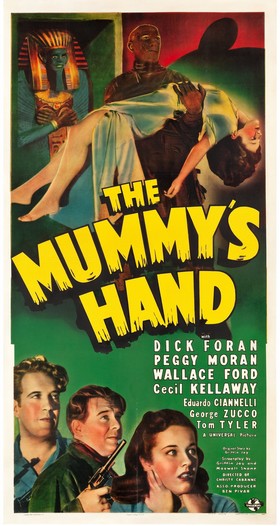 |
|

USA,
1940
A Universal Pictures Production
67 mins, black & white, 1.37:1 aspect ratio
Shot on 35mm film
Director - Christy Cabanne
Writer - Griffin Jay
Screenplay - Griffin Jay, Maxwell Shane
Cinematographer - Elwood Bredell
Production Design - Jack Otterson, Russell A.
Gausman (sets), Vera West (costumes)
Make-Up - Jack P. Pierce (uncredited)
Special Effects - Syd Pearson
Editor - Philip Cahn
Music - Hans J. Salter, Frank Skinner (both
uncredited)
Dick Foran
(Steve Banning), Peggy Moran (Marta Solvani),
Wallace Ford (Babe Jenson), Eduardo Ciannelli
(High Priest), George Zucco (Andoheb), Cecil
Kellaway (Mr Solvani), Tom Tyler (The Mummy)
|
|
| |
| PLOT
SUMMARY - Down on his luck
archaeologist Steve Banning discovers a vase in Cairo
that he believes could lead him to the ancient tomb of
Princess Ananka. But unknown to him, his colleague
Professor Andoheb is secretly also the High Priest of
Karnak who holds the secrets to Kharis, a mummy guarding
Ananka's tomb. Financed by a magician and his daughter,
an expedition is launched to the grave site - where the
awakended Kharis awaits them... |
| |
|
| |
| When Universal found itself with
two immensely successful horror movies in 1931 - Dracula
and Frankenstein - it was clear that
more was to follow, and in 1932, the studio's new
star Boris Karloff (billed as "Karloff the
Uncanny") starred in The Mummy.
Quite unlike Dracula and Frankenstein,
however, The Mummy lacked a literary
source, and this blank canvas was filled with an
original story and screenplay by Richard Schayer
and Nina Wilcox Putnam. The result was a movie
full of what would become classic imagery and
atmosphere. The
Mummy never quite reached the level of
awareness of its two predecessors, yet still
enjoyed a moderate box office success and spawned
several follow-up movies from Universal - of
which The Mummy's Hand is the first.
The movie is not an actual
sequel, since the Mummy is now called Kharis (as
opposed to Karloff's Imhotep) and is awakened by
mystical leaves (and not a magic incantation from
the life-giving "Scroll of Thoth"), but
The Mummy's Hand itself saw three
subsequent movies starring Kharis.
|
|
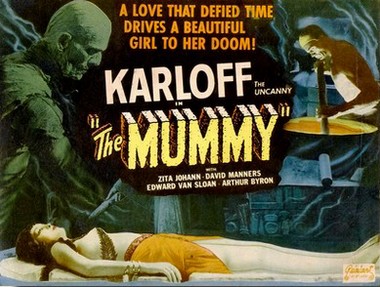
Poster advertising Universal's
1932 The Mummy with Boris Karloff
|
|
| |
| Whilst it is definitely the strongest of Universal's
four movies featuring Kharis the Mummy, The Mummy's
Hand does not compare too well to its predessor from
1932. Produced in May and June of 1940 on a modest budget
of $ 80,000, the movie was shot using a number of
cost-cutting measures, which included inserting stock
shots taken from the original Mummy, using leftover
studio sets from James Whale's film Green Hell, and
featuring a musical score almost entirely lifted from Son
of Frankenstein (Weaver, Brunas & Brunas, 1990). |
| |
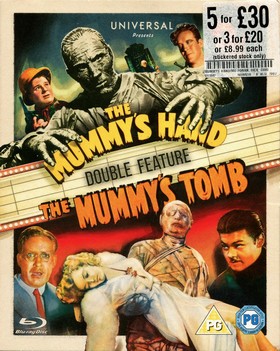
|
|
The result has its strong
moments, but overall comes across as a fairly
unbalanced end product which, even at a running
time of just 67 minutes, takes forever to get
into gear before ending on a stronger note. Tom Tyler, who previously
appeared mostly in Westerns, underwent an
excruciating make-up process which took hours to
complete and left him unable to speak (Weaver,
Brunas & Brunas, 1990), but his screen
presence - although menacing enough - lacked the
impact and weight Karloff had given the role
under similar circumstances.
First released in the USA
in September 1940, the movie received mostly
underwhelming reviews and, unlike most other
Universal horror movies from the 1930s and early
1940s, was never reissued for theatrical release
in the late 1940s and early 1950s (Weaver, Brunas
& Brunas, 1990).
The Mummy's Hand
has been available in various forms since the
days of laserdiscs and VHS cassettes; I only got
around to watching it after buying Universal's
2017 UK Bluray release (a double feature with the
second Kharis movie, The Mummy's Tomb
from 1942). The image and sound quality of this
are excellent, given the age of the source
material, and the 2k 1080p resolution provides
for what is most likely the best quality release
of this movie available.
|
|
| |
| Visually The Mummy's Hand
is a solidly made film, but Universal are nowhere near at
their best here, with The Mummy starring Boris
Karloff being by far the better film - which somewhat
begs the question why Denis Gifford chose this movie over
the 1932 film. |
| |
The answer can be found in his Pictorial History of Horror Movies:
"[The Mummy]
also revealed a waste: Karloff's mummified
monster had walked in but one short scene.
Griffin Jay, a writer of radio mysteries,
elaborated that single sequence into a whole
new mythos [for The Mummy's Hand]."
(Gifford, 1973)
In other words: whilst the
1932 movie set the iconic theme and atmosphere,
the iconic image of the bandage-wrapped Mummy
constantly lurking towards its victims was
introduced in The Mummy's Hand.
It also introduced the
additional punishment of cutting out the
perpetrator's tongue prior to embalming him
alive, "so the ears of the Gods would
not be assailed by his unholy curses".
It became a firm element of the Mummy mythos and
was shown in a graphic (for the time) scene in
Hammer's 1959 colour remake with Christopher Lee
as the Mummy - which is also based on the Kharis
story, not the 1932 Imhotep setting.
|
|
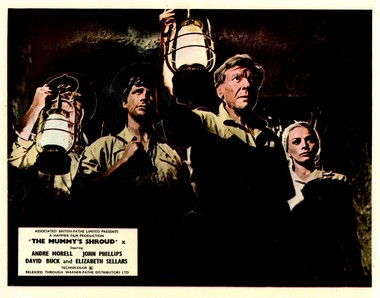
Original 1967 Lobby Card for
Hammer's The Mummy's Shroud
(personal collection)
|
|
| |
| All subsequent Hammer Mummy
movies contain at least some plot elelements or visuals
going back to The Mummy's Hand, making it just
as influential a movie as the original Mummy
from 1932. A good pick by Denis Gifford after all. |
| |
| |
|
| |
| |
| |
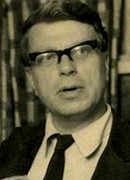 |
|
Denis Gifford on The
Mummy's Hand
in A Pictorial History of
Horror Movies (1973)
"The
Mummy's Hand (1940) was economical yet
looked expensive, thanks to its use of
the temple from Green Hell. It also used
the entire foggy flashback of Karloff's
incarceration (...) Im-Ho-Tep has changed
his name to Kharis. No longer a High
Priest, he is a Prince, in love with
Princess Anananka. When she dies he
steals not the Scroll of Thoth, but the
forbidden Tana leaves, the juice of which
will revive the dead. Caught, he is
buried alive."
|
|
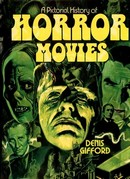 |
|
| |
|
| |
| |
| SOURCES GIFFORD
Denis (1973) A Pictorial History of Horror Movies,
Hamlyn
WEAVER Tom,
Michael Brunas & John Brunas (1990) Universal
Horrors, McFarland & Co
|
| |
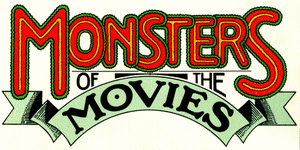
Back to main index page
|
| |
|
| |
The illustrations presented here are
copyright material.
Their reproduction in this non-commercial review
and research context is considered to be fair use
as set out by the U.S. Copyright Act of 1976, 17
U.S.C. par. 107
and in accordance with the the Berne Convention
for the Protection of Literary and
Artistic Works.
All images from
Monsters of the Movies
(Carousel/Transworld) were scanned from my
personal copy purchased in 1977
All images of Blu-ray or DVD covers were scanned
from my personal copies
All images of lobby cards were scanned from
copies in my personal collection
Page created 8
July 2023
Last updated 2 September 2023
(c)
2023

|
|
| |